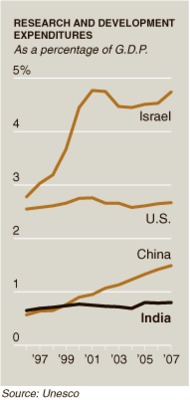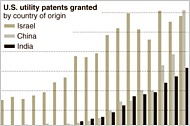BANGALORE, India — In the United States and Europe, people worry that their well-paying, high-skill jobs will be, in a word, “Bangalored” — shipped off to India.

People here are also worried about the future. They fret that Bangalore, and India more broadly, will remain a low-cost satellite office of the West for the foreseeable future — more Scranton, Pa., in the American television series “The Office,” than Silicon Valley.
Even as the rest of the world has come to admire, envy and fear India’s outsourcing business and its technological prowess, many Indians are disappointed that the country has not quickly moved up to more ambitious and lucrative work from answering phones or writing software. Why, they worry, hasn’t India produced a Google or an Apple?
Innovation is hard to measure, but academics who study it say India has the potential to create trend-setting products but is not yet doing so. Indians are granted about half as many American patents for inventions as people and firms in Israel and China. The country’s corporate and government spending on research and development significantly lags behind that of other nations. And venture capitalists finance far fewer companies here than they do elsewhere.
“The same idea, if it’s born in Silicon Valley it goes the distance,” said Nadathur S. Raghavan, a investor in start-ups and a founder of Infosys, one of India’s most successful technology companies. “If it’s born in India it does not go the distance.”
Mr. Raghavan and others say India is held back by a financial system that is reluctant to invest in unproven ideas, an education system that emphasizes rote learning over problem solving, and a culture that looks down on failure and unconventional career choices.
Sujai Karampuri is an Indian entrepreneur who has struggled against many of these constraints.
His Bangalore-based company, Sloka Telecom, has developed award-winning radio systems that are more flexible, smaller and less expensive than equipment used by phone companies today. Mobile phone companies and larger telecommunications equipment suppliers are buying and testing his products, but he has not been able to interest Indian venture capitalists. For the last five years he has run his firm on $1 million he raised from acquaintances.
“I can only afford to trial with one customer at a time and that takes three months to materialize,” said Mr. Karampuri, who has considered moving the company to the United States to be closer to venture capitalists who specialize in telecommunications. “You are always worried about paying next month’s salary to people. Should you keep the money for this trial or next month’s salary?”
Companies like Sloka Telecom are important, analysts say, because they are more likely to create the next wave of jobs than large, established Indian technology companies, many of which are experiencing slower growth. These companies could also help offset some of the outsourcing jobs the country will likely lose because of greater automation and competition from countries where costs are even lower.
There are historical reasons that starting a business in India is difficult. During British rule, imperial interests dictated economic activity; after independence in 1947, central planning stifled entrepreneurship through burdensome licensing and direct state ownership of companies and banks.
Businesses found that currying favor with policy makers was more important than innovating. And import restrictions made it hard to acquire machinery, parts or technology. Inventors came up with ingenious ways to overcome obstacles and scarcity — a talent Indians used the Hindi word “jugaad” (pronounced jewgard) to describe. But the products that resulted from such improvisation were often inferior to those available outside India.
“We were in an economy where, forget innovation, expansion was discouraged, creating wealth was frowned upon, there was no competition to speak of,” said Anand G. Mahindra, who heads the Mahindra & Mahindra business group and has spoken about the need for more innovation.
Indian leaders began embracing the free market in the 1980s and stepped up the pace of change in 1991 when the country faced a financial crisis. Those changes increased economic growth and made possible the rise of technology companies like Infosys and Wipro, which focused on providing services for American and European corporations.
Yet, the government still exerts significant control, especially in manufacturing, said Rishikesha T. Krishnan, a professor at the Indian Institute of Management in Bangalore.
“To start a services company it really takes you just two or three days to get going,” said Mr. Krishnan, whose book, “From Jugaad to Systematic Innovation: The Challenge for India,” is to be published next year. “The moment you are looking at manufacturing, there are hundreds of inspectors and regulations.”
Raising money is one of the biggest challenges entrepreneurs face. Venture capital funds have flocked to India in recent years, but they are more likely to invest in established businesses than young firms.

People here are also worried about the future. They fret that Bangalore, and India more broadly, will remain a low-cost satellite office of the West for the foreseeable future — more Scranton, Pa., in the American television series “The Office,” than Silicon Valley.
Even as the rest of the world has come to admire, envy and fear India’s outsourcing business and its technological prowess, many Indians are disappointed that the country has not quickly moved up to more ambitious and lucrative work from answering phones or writing software. Why, they worry, hasn’t India produced a Google or an Apple?
Innovation is hard to measure, but academics who study it say India has the potential to create trend-setting products but is not yet doing so. Indians are granted about half as many American patents for inventions as people and firms in Israel and China. The country’s corporate and government spending on research and development significantly lags behind that of other nations. And venture capitalists finance far fewer companies here than they do elsewhere.
“The same idea, if it’s born in Silicon Valley it goes the distance,” said Nadathur S. Raghavan, a investor in start-ups and a founder of Infosys, one of India’s most successful technology companies. “If it’s born in India it does not go the distance.”
Mr. Raghavan and others say India is held back by a financial system that is reluctant to invest in unproven ideas, an education system that emphasizes rote learning over problem solving, and a culture that looks down on failure and unconventional career choices.
Sujai Karampuri is an Indian entrepreneur who has struggled against many of these constraints.
His Bangalore-based company, Sloka Telecom, has developed award-winning radio systems that are more flexible, smaller and less expensive than equipment used by phone companies today. Mobile phone companies and larger telecommunications equipment suppliers are buying and testing his products, but he has not been able to interest Indian venture capitalists. For the last five years he has run his firm on $1 million he raised from acquaintances.
“I can only afford to trial with one customer at a time and that takes three months to materialize,” said Mr. Karampuri, who has considered moving the company to the United States to be closer to venture capitalists who specialize in telecommunications. “You are always worried about paying next month’s salary to people. Should you keep the money for this trial or next month’s salary?”
Companies like Sloka Telecom are important, analysts say, because they are more likely to create the next wave of jobs than large, established Indian technology companies, many of which are experiencing slower growth. These companies could also help offset some of the outsourcing jobs the country will likely lose because of greater automation and competition from countries where costs are even lower.
There are historical reasons that starting a business in India is difficult. During British rule, imperial interests dictated economic activity; after independence in 1947, central planning stifled entrepreneurship through burdensome licensing and direct state ownership of companies and banks.
Businesses found that currying favor with policy makers was more important than innovating. And import restrictions made it hard to acquire machinery, parts or technology. Inventors came up with ingenious ways to overcome obstacles and scarcity — a talent Indians used the Hindi word “jugaad” (pronounced jewgard) to describe. But the products that resulted from such improvisation were often inferior to those available outside India.
“We were in an economy where, forget innovation, expansion was discouraged, creating wealth was frowned upon, there was no competition to speak of,” said Anand G. Mahindra, who heads the Mahindra & Mahindra business group and has spoken about the need for more innovation.
Indian leaders began embracing the free market in the 1980s and stepped up the pace of change in 1991 when the country faced a financial crisis. Those changes increased economic growth and made possible the rise of technology companies like Infosys and Wipro, which focused on providing services for American and European corporations.
Yet, the government still exerts significant control, especially in manufacturing, said Rishikesha T. Krishnan, a professor at the Indian Institute of Management in Bangalore.
“To start a services company it really takes you just two or three days to get going,” said Mr. Krishnan, whose book, “From Jugaad to Systematic Innovation: The Challenge for India,” is to be published next year. “The moment you are looking at manufacturing, there are hundreds of inspectors and regulations.”
Raising money is one of the biggest challenges entrepreneurs face. Venture capital funds have flocked to India in recent years, but they are more likely to invest in established businesses than young firms.

